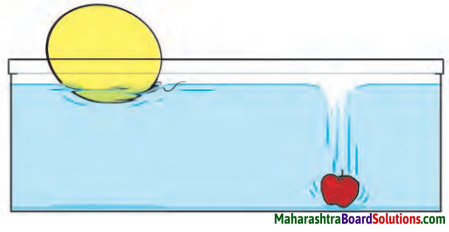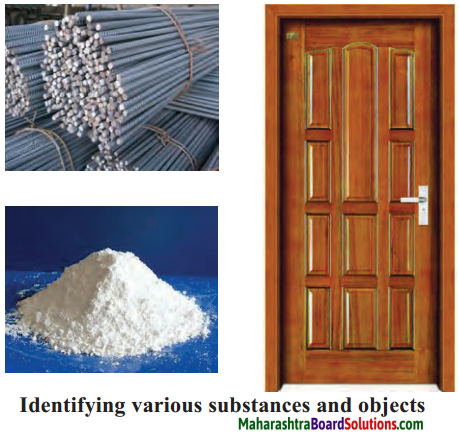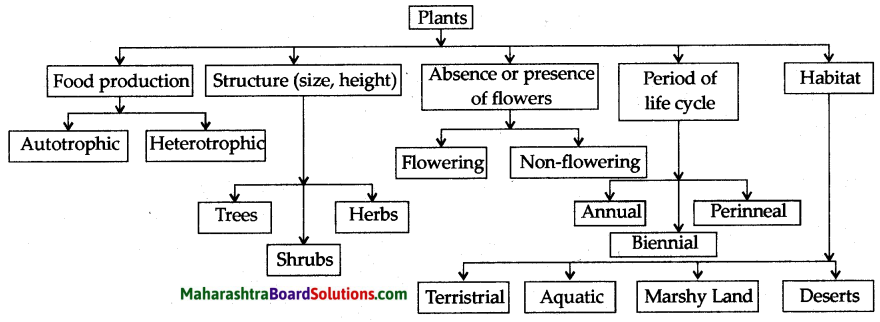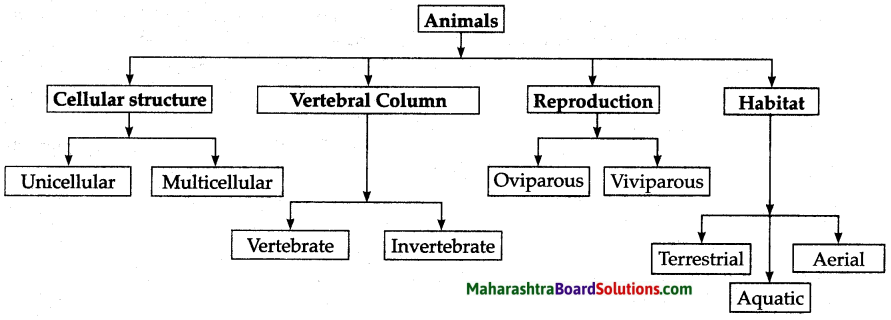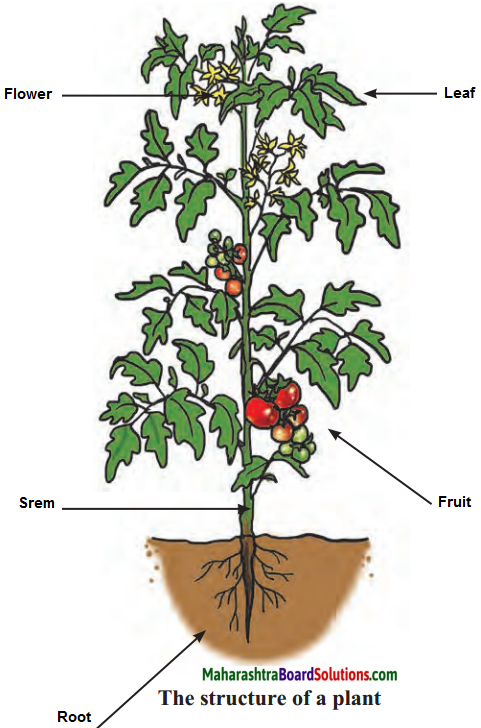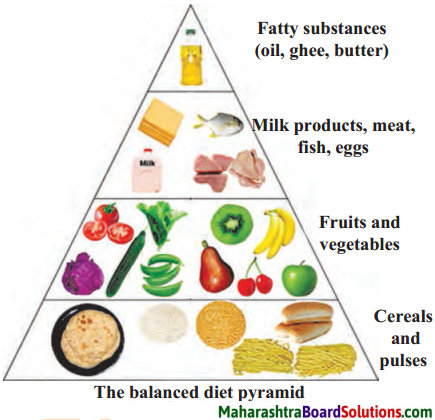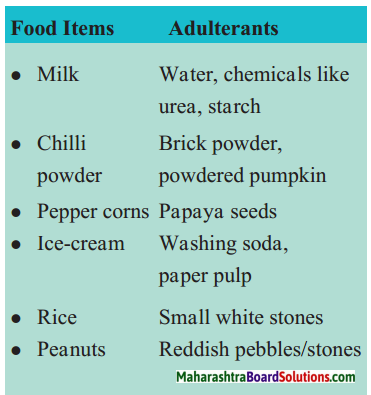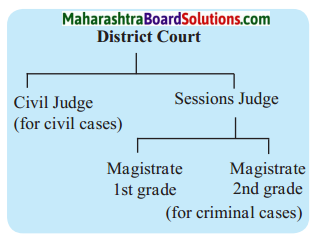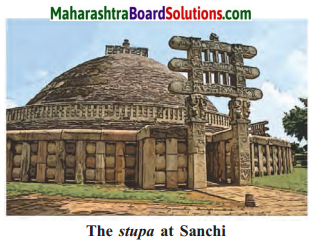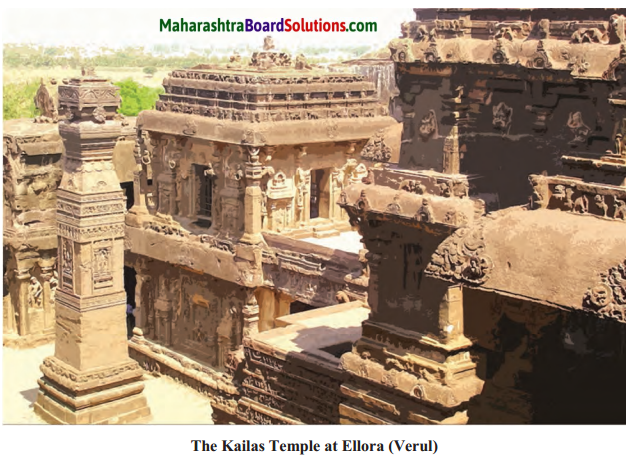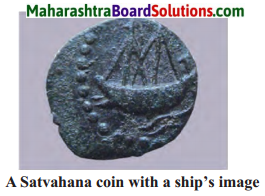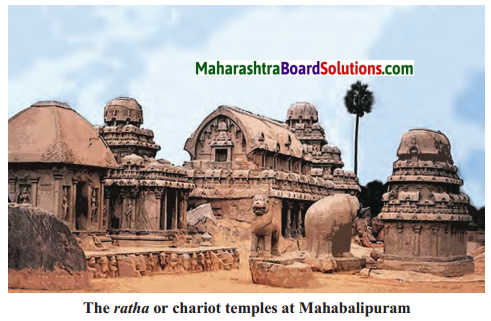Balbharti Maharashtra State Board Class 6 Science Solutions Chapter 6 Substances in Daily Use Notes, Textbook Exercise Important Questions and Answers.
Maharashtra State Board Class 6 Science Solutions Chapter 6 Substances in Daily Use
Class 6 Science Chapter 6 Substances in Daily Use Textbook Questions and Answers
1. Fill in the blanks using proper works:
Question a.
Rubber made by vulcanization is a …………… material.
Answer:
hard
Question b.
Man-made materials are made by …………… natural materials.
Answer:
processing
![]()
Question c.
…………… thread was developed simultaneously in New York and London.
Answer:
Nylon
Question d.
Rayon is also known as …………… .
Answer:
synthetic silk
2. Answer the following questions.
Question a.
Why did the need for man-made materials arise?
Answer:
The need for man-made materials arose due to the following reasons:
- To meet the needs of an increasing population.
- Human nature to try to make life more comfortable.
- They can be made available in plenty at a low cost.
- The reserve of natural substances is decreasing.
![]() c
c
Question b.
Which are the natural materials obtained from plants and animals?
Answer:
Leather, jute, wool, cotton, silk are the natural substances obtained from plants and animals.
Question c.
What is vulcanization?
Answer:
- Vulcanization is the process in which rubber is heated with sulphur for three to four hours.
- Sulphur is mixed to give hardness to rubber.
- The proportion of sulphur depends on the purpose for which the rubber is to be used.
Question d.
Which natural materials are used to obtain fibres?
Answer:
Cotton, wood pulp and various hydrocarbons obtained from mineral oils are used to obtain fibres.
3. What are we used for?
Question a.
What are we used for?
Answer:
- Soil: It supports plant life and hence indirectly supports all living things. It is used for making clay pot, utensils, bricks etc.
- Wood: It is used in paper industry. It is also used to make furniture.
- Nylon: It is used to manufacture clothes, fishing nets, ropes, etc.
- Paper. It is used in our textbooks, note books, currency notes, etc.
- Rubber: It is used in the manufacture of erasers, tyres, rubber toys, rubber bands, etc.
![]()
4. How is paper manufactured? Write in your own words.
Question a.
How is paper manufactured? Write in your own words.
Answer:
Coniferous trees like pine trees are used to make paper.
- The bark of the logs of these trees is first removed and the wood is broken into small pieces.
- The mixture of these pieces with some chemicals is kept soaked for a long time to form pulp.
- On completion of chemical process, fibrous substances from wood pulp are separated and some dyes are added.
- The pulp is then passed through rollers, dried to form paper and finally wound on reels.
5. Give scientific reasons.
Question a.
We must use cotton clothes during summer.
Answer:
- During summer we sweat more due to high temperature.
- Cotton clothes absorb sweat.
- Synthetic clothes are water repellent. They do not absorb sweat and we feel uncomfortable. Hence we must use cotton clothes in summer.
![]()
Question b.
We must observe economy in the use of materials.
Answer:
- Due to excessive use of natural substances by human beings to fulfil their needs; they are getting depleted at a faster rate.
- At the same time, it takes a very long time for these substances to get naturally formed again.
- Hence, we must observe economy in the use of materials so that they are available for the future generation also.
Question c.
Saving paper is the need of the hour.
Answer:
- Saving paper means saving trees as wood is used as the raw material to manufacture paper.
- Trees are natural habitat for many Living things.
- Trees help in increasing rainfall and water availability. Hence, saving paper helps in saving trees which in turn maintains balance in nature.
Question d.
Man-made materials have more demand.
Answer:
- Man-made substances are waterproof, lightweight and easy for transportation.
Substances in Daily Use - They are easier to use and can be made available in plenty at a low cost.
Hence, there is more demand for man-made materials.
![]()
Question e.
Humus is a natural material.
Answer:
- Humus is obtained from plant and animal wastes.
- Micro-organisms act on these wastes and convert them into humus.
- Hence, humus is a natural material.
6. Find out.
Question 1.
How is lac obtained from nature?
Answer:
- Lac is a resinous substance secreted from the glands present in the skin of female lac insect.
- Lac insects live on the Palash trees. In India lac is mainly produced in the states of Rajasthan and Bihar.
Question 2.
How are pearls obtained?
Answer:
- Pearls are formed when a foreign particle such as a grain of sand or a small particle of rock accidentally enters the space between the mantle and shell of an oyster’s body.
- Oysters cannot reject the particle, and as a defence mechanism its produces a shining coating called nacre on the particle layer by layer.
- As the shiny layers get added, a pearl is formed.
- Cultured pearls are artificially formed by inserting a bead in oyster shell and allowed to coat it with nacre over several years.
![]()
Activity:
Question 1.
Visit a rubber, paper or textile industry in your area and collect information about it.
Question 2.
Collect various samples of paper and note their uses.
Question 3.
Use blank pages from old note-books and make a new one.
Class 6 Science Chapter 6 Substances in Daily Use Important Questions and Answers
Fill in the blanks using proper works.
Question 1.
Natural rubber is obtained from …………… of trees.
Answer:
latex
Question 2.
Changes where the original constituent substances cannot be obtained again from the new substances are called …………… changes.
Answer:
irreversible
![]()
Question 3.
A paper factory in Maharashtra is situated at …………… .
Answer:
Ballarpur
Question 4.
Glass can be made from …………… and …………… .
Answer:
sand, calcium
Question 5.
Botanical name of rubber plant is …………… .
Answer:
Hevea brasiliensis
Question 6.
…………… obtained from mineral oils are used to make polymer chains.
Answer:
Hydrocarbons
Question 7.
The maximum production of rubber in India is in …………… .
Answer:
Kerala
![]()
Question 8.
…………… invented the process of vulcanisation.
Answer:
Charles Goodyear
Match the columns:
Question 1.
| Column ‘A’ | Column ‘B’ |
| 1. Jute | a. Animal origin |
| 2. Air | b. Plant origin |
| 3. Leather | c. Man-made |
| 4. Cement | d. Abiotic |
Answer:
| Column ‘A’ | Column ‘B’ |
| 1. Jute | b. Plant origin |
| 2. Air | d. Abiotic |
| 3. Leather | a. Animal origin |
| 4. Cement | c. Man-made |
![]()
State whether the following statements are ‘true’ or ‘false’.
Question 1.
We can find plastic in nature.
Answer:
False
Question 2.
Soap is a man-made substance.
Answer:
True
Question 3.
We should reuse available resources.
Answer:
True
![]()
Question 4.
Nylon clothes are good summer wear.
Answer:
False
Question 5.
Glass is a man-made substance.
Answer:
True
Question 6.
In irreversible changes original substances can be obtained again.
Answer:
False
Question 7.
Rayon is made up of cotton and wood pulp.
Answer:
True
Give two examples of each of the following:
Question 1.
Natural fibres
Answer:
cotton, silk
![]()
Question 2.
Synthetic fibres
Answer:
terylene, rayon
Question 3.
Biotic natural substances
Answer:
wool, jute
Question 4.
Abiotic natural substances
Answer:
air, water
Question 5.
Man-made substances.
Answer:
paper, glass
Classify the following substances in the table given below.
(iron, wood, brick, paper, terylene, stone, jute, air, silk, utensils, plastic, rayon, water, wool, dacron, lac, nylon, pearl)
Answer:
| Natural Substances | Man-made Substances Natural Fibres | Synthetic Fibres | |
| iron, wood, stone, water, lac, pearl | brick, paper, utensils, plastic | jute, silk, wool | terylene, rayon, dacron, nylon |
![]()
Define:
Question 1.
Natural substances.
Answer:
Substances available in nature are called natural substances.
Question 2.
Man-made substances.
Answer:
Man-made substances are new substances produced by processing naturally available resources.
Question 3.
Biotic substances.
Answer:
Natural substances obtained from living things are called biotic substances.
![]()
Question 4.
Abiotic substances.
Answer:
Natural substances that are not obtained from living things are called abiotic substances.
Question 5.
Plant-originated substance.
Answer:
A substance obtained from a plant is called a plant-originated substance.
Question 6.
Animal-originated substance.
Answer:
A substances obtained from an animal is called an animal-originated substance.
Question 7.
Hydrocarbons.
Answer:
Substances obtained from mineral oil are called hydrocarbons.
![]()
Answer the following in one or two sentences.
Question 1.
Why was Rayon named so?
Answer:
The threads of Rayon have shine and strength. They appeared to be shining bright like the sun’s rays. Hence, they were named ‘Rayon.
Question 2.
How are TV sets, refrigerators, etc. packed? Why?
Answer:
To pack TV sets, refrigerators, etc. big cartons and thermocol are used. These man-made substances are water resistant, light weight and easy for transportation.
Question 3.
Give the properties and uses of nylon.
Answer:
Nylon threads have a shine and are strong, transparent and water resistant. They are used to manufacture clothes, fishing nets, ropes, etc.
![]()
Question 4.
What is latex?
Answer:
Latex is a milky white natural substance produced in the stems of rubber trees.
Question 5.
Name the basic material used to obtain paper.
Answer:
Wood is the basic material used in the manufacture of paper.
Question 6.
What kind of paper is used for currency notes manufacturing?
Answer:
Flax fibre is used in the manufacture of currency notes.
Question 7.
Where was the process of making paper invented?
Answer:
The process of making paper was invented in China.
Answer in brief:
Question 1.
What are the advantages of synthetic fibre?
Answer:
Advantages of synthetic fibre are:
- These fibres can be manufactured on a large scale.
- They cost less.
- They are strong and durable.
- They can be used for a long time.
- They are water repellent. They dyy easily.
- They are light weight and comfortable to wear.
- Clothes made from these threads are wrinkle free and scratch free.
![]()
Question 2.
Give the shortcomings of synthetic fibre.
Answer:
- They are water repellent. Hence, they do not absorb sweat from the skin.
- Continuous use of these clothes keeps the skin moist which may cause skin diseases.
- Synthetic clothes are uncomfortable to wear especially in summer.
- They catch fire easily.
- If they catch fire, they stick to the skin and cause skin injuries.
- These fibres are not decomposed by micro-organisms.
Question 3.
Write a short note on natural rubber.
Answer:
- Rubber is a natural substance obtained by collecting the latex of certain trees.
- The botanical name of this tree is ‘Hevea brasiliensis’
- In India, the maximum production of rubber is in Kerala.
Question 4.
What are dacron, terylene and terene?
Answer:
- Dacron, terelyne and terene are synthetic fibres prepared from hydrocarbons.
- Various hydrocarbons obtained from mineral oil are used to make polymer chains.
- A solution of such polymer is pressed through a strainer with fine holes.
- The fibre formed after cooling are long and unbroken threads.
- These threads have been named as dacron, terylene and terene.
![]()
Give scientific reasons:
Question 1.
Natural substances are depleting.
Answer:
- Due to increase in population there is an increase in demand. To meet this demand, natural substances are used to a greater extent.
- Due to human nature to make his life more comfortable, he learnt to use natural resources and also began to process them to make new substances. Hence natural substances are depleting at an alarming rate.
Can you tell?
Question 1.
Difference between leather, jute, wool, cotton and soil, water, metals.
Answer:
- Leather, jute, wool are biotic natural substances.
- Soil, water, metals are abiotic natural substances.
![]()
Question 2.
How are leather and wool different from jute and cotton?
Answer:
Leather and wool are obtained from animals while jute and cotton are obtained from plants.
Question 3.
Do you find plastic, nylon, brass or cement in nature?
Answer:
No, they are all man-made materials.
Question 4.
Can red chillies become green chillies again?
Answer:
No, the change from green chillies to red chillies is irreversible.
Question 5.
From which substances in nature can we get threads or fibre?
Answer:
Cotton plant, jute, silkworm.
![]()
Question 6.
What are clothes made from?
Answer:
Clothes are made from yarn obtained from fibre.
Classify the following substances according to their uses:
sand, soap, wool, window glass, bamboo, cotton, bricks, silk, leafy vegetables, cement, fruits, water, sugar.
Answer:
- For construction: Sand, window glass, bamboo, bricks, cement.
- As food: Leafy vegetables, fruits, water, sugar.
- At home: Soap for cleaning.
- For clothes: Wool, cotton, silk.
Make a list of objects, each of which can be made from several substances.
Answer:
| Objects | Substances |
| Table | Wood, glass, plastic. |
| Toys | Wood, plastic, clay. |
| Utensils | Aluminium, wood, glass, ceramic, plastic. |
![]()
Use your brain power!
Question 1.
Complete the table below, showing how substance of daily use are classified.
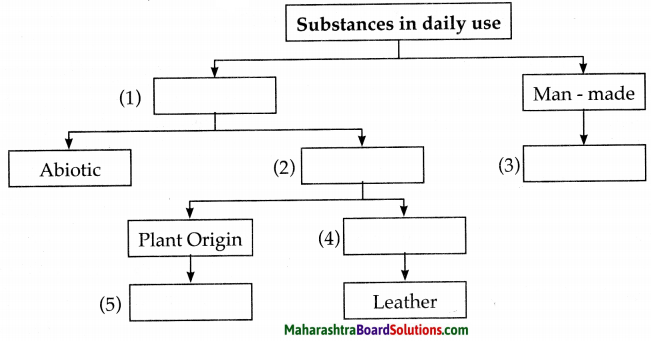
Answer:
- Natural
- Biotic
- Cement
- Animal Origin
- Cotton
